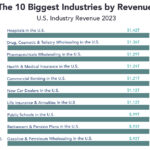May 30, 2023

How Big is the Revenue Cycle Management (RCM) Business? You Tell Us.
In November 2022, I published an article in HFM Magazine with the provocative title “Rewiring Healthcare’s Smartest Professionals (Hint: It’s Not Doctors).” I wrote the article to make the following points:
- Revenue optimization is the primary driver of healthcare operations. It shapes which services providers offer, where they offer those services and the prices they charge for them. Inequitable access and poor health outcomes are byproducts of the nation’s current system of delivering and paying for healthcare services.
- Providers and payers dedicate the vast majority of their technological expertise to managing remarkably complex and friction-filled billing and payment processes.
- Revenue cycle management (RCM) in healthcare is very expensive to operate, is riddled with inconsistencies and creates negative value for patients to the point where, according to NORC research, more Americans fear paying medical bills than contracting a serious disease.
- Redirecting RCM’s talent and expertise into value-creating service provision has the potential to revolutionize U.S. healthcare service provision.
In writing the article, I wanted to give readers a sense of the RCM market’s absolute size as well as its relative size within the overall U.S. economy. Here’s what I discovered:
According to a report issued by Grand View Research, the U.S. RCM market in 2022 was $140.4 billion and projected to grow 10.3% annually through 2030. By comparison, Ibis World estimates the 2022 U.S. car and automobile market to be $100.9 billion, growing at just 2.6% this year.
In today’s America, processing medical claims is far more lucrative than the manufacturing, selling and servicing of all the nation’s cars and trucks.
That comparison generated an enormous amount of interest. Given RCM’s scale and growth potential, it’s no wonder that private equity and venture firms are funneling so much investment into RCM companies. They’re following the money.
This got my colleague 4sight Health News Editor David Burda and me wondering about the market dynamics of the RCM business within the larger U.S. healthcare economy. Like me, Burda walks a fine line between skepticism and cynicism when analyzing the healthcare marketplace. He found it beyond ironic that Becker’s Report listed the 274 RCM companies to know in 2023 — not the Top 10 but the Top 274!
Given the RCM market’s size, it’s remarkable there isn’t more aggregate data on the sector. The Grand View Research report was the only macro assessment of the RCM marketplace that I could find. I’d never heard of Grand View Research. They certainly lack the market stature of leading industry analysts, such as McKinsey, Deloitte and Kaiser Health News.
Before submitting the article for publication, I checked with HFMA’s research team to validate the Grand View analysis. They affirmed that the Grand View report was their primary source for macro statistics on the RCM industry.
Here’s the rub. The Grand View report only accounts for RCM services outsourced to third-party vendors. As such, the Grand View analysis does not include the massive internal investment in RCM by healthcare’s payers and providers. So how much bigger is the total RCM business than the outsourced RCM services documented by Grand View Research?
That’s where informed readers like you have a role to play. We’d like your help in defining the scale and configuration of the RCM marketplace. Beyond outsourced RCM services, we’d like to estimate the sector’s total size, including internal provider and payer investment.
Before asking for your specific input, let me provide some context that may shape your analytic frame. In October 2022, Health Affairs published a meta-analysis of research reports documenting the level of administrative waste in U.S. healthcare spending.
The Health Affairs report analyzed seven separate studies of healthcare’s administrative costs published between 2003 and 2021. These studies found administrative expenditures ranged between 15% to 30% of total U.S. healthcare expenditure.
The variation of these results is quite wide and leaves abundant room for error. It speaks to the alarming lack of clarity regarding healthcare’s administrative costs. Providers and payers account for much of their administrative activities within ongoing operations in ways that are difficult to isolate. Opaque accounting makes insightful analysis difficult to achieve.
According to the Centers for Medicare and Medicaid Services (CMS), U.S. healthcare expenditure in 2021 was $4.3 trillion, representing 18.3% of the total U.S. economy. Simple multiplication suggests that healthcare’s administrative expenses in 2021 ranged between $645 billion (15% of total) and $1.29 trillion (30% of total). These represent the outer boundaries of RCM expenditure in the U.S. They would be even higher today.
One trillion is an unimaginably big number, almost beyond human comprehension. I once figured out how many years equate to living a million, a billion and a trillion seconds. The answers are 1.9 years, 32 years and 32,000 years. A trillion dollars spent each year on healthcare administration is within the realm of reason. At the same time, that level of expenditure to process medical claims is beyond reason, even shameful.
As the chart below from Ibis World documents, the massive healthcare ecosystem contains the four largest U.S. industries. At its highest potential level ($1.29 trillion), healthcare’s administrative expenditure is larger than the next biggest non-healthcare industry, commercial banking (No. 5 at $1.21 trillion). It’s not a stretch to conclude that RCM is America’s fastest-growing large industry. It’s time to understand its macro and micro fundamentals in much more granular detail.

Consider the non-healthcare industries listed above. Each industry receives in-depth investor analysis that dissects the individual sectors within the industry as well as the industry as a whole. According to the Bureau of Labor Statistics, for example, the automotive industry incorporates segments related to production, wholesaling, retailing and maintenance of motor vehicles.
By comparison, the marketplace knows relatively little about the inner-workings of the RCM industry. Given its size and complexity, it is inexcusable that the broader marketplace has such an atrophied view of RCM operations. Lack of transparency encourages profiteering and sub-optimal resource utilization. Better knowledge would translate into more effective service provision. Increased value and customer satisfaction would result.
This is where you, our readers, can join our quest for revolutionary knowledge and system change. We can’t fix our broken healthcare system until we document and define its specific problems. Runaway spending on RCM is a big problem.
Here’s my ask of you. Send us your estimates regarding the total size of the U.S. RCM marketplace to 4sight Health on LinkedIn. Make sure to explain your reasoning. If we get enough intriguing responses, we’ll share them in a follow-up commentary.
We offer the following soundtrack selection to motivate your deep dive into RCM operations: Churn Baby Churn by our very own 4sight Health troubadour John Zam, the Piano Man. Enjoy and remember: Outcomes matter, customers count and value rules!





